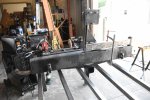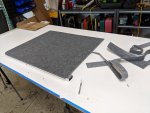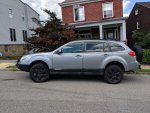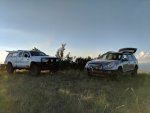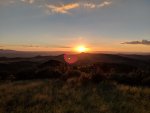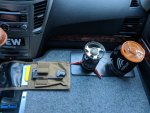Day 4-8:
Aside from the bumpers, we replaced the suspension system and installed the Anderson Design lift kit. Being an east coast vehicle, there was plenty of rust to play with and probably doubled the time spent on the suspension rebuild. Be careful compressing the springs! Sketchy stuff but we had no issues. We ran into a few problems installing the lift kit. In the front it is necessary to detach the front sway bar links in order to be able to get the strut assembly back up into place. Mine were so frozen over with rust we had to cut them off and just get new ones. In the rear, the kit lowers the subframe so its necessary to detach certain points of the subframe. Having the subframe lowered adds quite a bit more articulation to the vehicle. There are six points of sub frame lift in the rear. Definitely a very good quality and well thought out kit.
* Note that the front bumper in some of the photos is upside down, its easier to see the skirt work this way *
- Front and rear bumpers finished up fab work
- Suspension rebuild finished
Aside from the bumpers, we replaced the suspension system and installed the Anderson Design lift kit. Being an east coast vehicle, there was plenty of rust to play with and probably doubled the time spent on the suspension rebuild. Be careful compressing the springs! Sketchy stuff but we had no issues. We ran into a few problems installing the lift kit. In the front it is necessary to detach the front sway bar links in order to be able to get the strut assembly back up into place. Mine were so frozen over with rust we had to cut them off and just get new ones. In the rear, the kit lowers the subframe so its necessary to detach certain points of the subframe. Having the subframe lowered adds quite a bit more articulation to the vehicle. There are six points of sub frame lift in the rear. Definitely a very good quality and well thought out kit.
* Note that the front bumper in some of the photos is upside down, its easier to see the skirt work this way *









